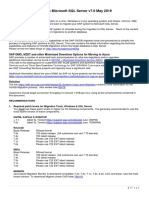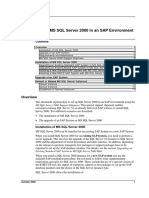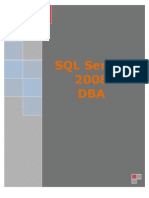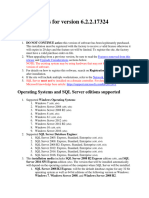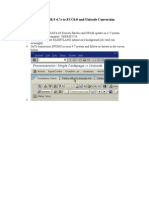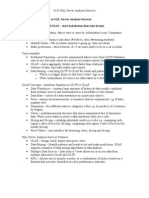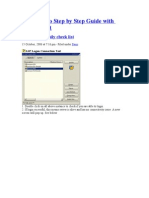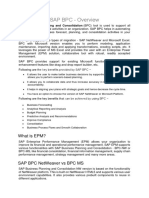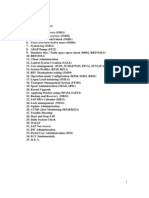0 ratings 0% found this document useful (0 votes) 60 views 5 pages SAP Tools For MS SQL Server
SAP Note 683447 outlines the use of SAP Tools for MS SQL Server, which assist in configuring database parameters for SAP systems running on MS SQL Server. It details various functionalities such as system copy, schema conversion, and database upgrade completion, along with prerequisites and necessary steps for execution. The note emphasizes the importance of using the correct version of the Software Provisioning Manager (SWPM) and provides guidance on managing AlwaysOn nodes and addressing known issues.
AI-enhanced title and description
Copyright
© © All Rights Reserved
We take content rights seriously. If you suspect this is your content,
claim it here .
Available Formats
Download as PDF or read online on Scribd
Go to previous items Go to next items
Save SAP Tools for MS SQL Server For Later Dy SAP Note
683447 - SAP Tools for MS SQL Server
Component: BC-DB-MSS-INS (SQL Server Installation for SAP NetWeaver Products), Version: 48, Released On:
20.10.2022
| symptom
This SAP Note describes the use of SAP Tools for MS SQL Server. The SAP Tools for MS SQL
Server are based on the SwPM based installation procedures and are used to configure
database-related parameters of an Sap system that is running with MS SQL Server
The SAP Tools for MS SQL Server are part of the SAP Software Provisioning Manager (SWPM),
which is part of the SL Toolset program.
Please check SAP note 1563579 for the download location of the current SL Toolset SP on SMP.
7 . itfer u sovi sens
Provisioning Manager: 7OSWPM*.SAR and SWPM*.SAR - but only the latter contains the SAP
Tools for SQL Serve
You can find the SAP Tools for MS SQL Server on the SwPM welcome screen at the following
location:
-> Generic Installation options
“> MS SQL Server
-> Database Tools
If not stated differently in this note, all the STM services delivered with the SwPM tool
can be applied for R/3 4.6c, R/3 4.7 as well as for all SAP products based on NW 6.40 and
higher.
| other Terms
MSS, MSSQL, SQL Server 2000, SQL Server 2005, SQL Server 2008, SQL Server 2012, SQL server
2014, SQL Server 2016, SQL Server 2017, SQL Server 2019, SQL Server 2022, system copy,
detach, attach, schena conversion, STM
Reason and Prerequisites
You use the SAP Tools for MS SQL Server to:
+ Perform the final adjustments on the database required when performing a system copy
using the detach/attach or backup/restore method.
This only applies to SAP systems based on SAP NetWeaver 6.40 or lower.
If you want to copy an SAP system based on SAP NetWeaver 7.0 or higher, you must perform
the standard system copy procedure offered by SWPM/70SWPM Using the detach/attach or
backup/restore method.
+ Convert the SAP system to a schena-based configuration
+ Upgrade your sql server.
This applies to all SAP releases starting with 4.6C, including upgrades to sql 2005, sat
Server 2008 (R2), SQL Server 2012, SQL Server 2014, SQL Server 2016, SQL Server 2017,sQL
Server 2019 and Sql server 2022.
+ Configure Alwayson Nodes.
This applies to SQL Releases starting with SQL Server 2012.�| Solution
General
This note describes the different tasks that you can perform with the SAP Tools for MS SQL
server.
Do not use the user adm for the execution of the SAP Tools for MS SQL Server.
Schema Conversion
IMPORTANT: This schema conversion is now part of all the system copy procedures including
"Refresh or Move Database Content" and "Refresh Database Content". You don't need
to execute this "Schema Conversion" procedure to convert a source schema to the target
Schema before an SWeM system copy related procedure.
Use the "Schema Conversion" option of the SAP Tools for MS SQL Server ONLY to convert
your system from a dbo-based to a schema-based configuration.
You must convert the system if you want to:
+ Instal1_a Java Add-In to an ABAP system that was upgraded from a release prior to 6.20
to a release 6.20 or higher.
In this case, you must convert the schema before you install the Java Add-in
+ Use the MCop functionality (multiple systems share the same database) with the ABAP
system that was upgraded from a release prior to 6.20 to a release 6.20 or higher
In this case, you must convert the schema before you install the additional sap system.
To find out whether you must run this option in these two cases, check the parameter
dbs/mss/schema in the default profile of your system (normally default.pfl under
usr\sap\stD\sys\profiles)
If this parameter does not exist or is set to dbo, you must perform the conversion.
If the parameter is set to of your system in lower case, a conversion is not
necessary (this check implies that your system is operable).
Before you run the "Schema Conversion” option of the SAP Tools for MS SQL Server make sure
that
+ The system is stopped.
+ You have a current backup of the database
+ If you are using the ew functionality, check SAP Note 449891, and delete the temporary
objects described there. otherwise, the conversion might take a very long time.
Database Upgrade Completion
Use the "Database Upgrade Completion" option of the SAP Tools for MS SQL Server to perform
mandatory tasks on the database after you upgraded your SQL Server to SQL Server 2005 or
higher with the sql Server setup. If you copied and attached an SQL Server 2000 database to
an SQL Server 2005 server, use the "Database Copy Completion” option of the SAP Tools for MS
SQL Server instead.
For general information about the upgrade to
+ MS SQL Server 2005, see SAP Note 799058
+ MS SQL Server 2008, see SAP Note 1152240
+ MS SQL Server 2012, see SAP Note 1676665
+ MS SQL Server 2014, see SAP Note 196670.
+ MS SQL Server 2016, see SAP Note 2201059
+ MS SQL Server 2017, see SAP Note 2484674
+ MS SQL Server 2019, see SAP Note 2779625
+ MS SQL Server 2022, see SAP Note 3218783
Before you run the “Database upgrade Completion” option of the SAP Tools for MS SQL Server,
make sure that:�+ The system is stopped.
+ You have a current backup of the database
+ Your source system fulfills the requirements on the basis support package level that is
described in the SQL Server release SAP Notes 905634 (sQl Server 2005), 1076022 (SQL
Server 2008 (R2)), 1651862 (SQL Server 2012), 1966681 (sql Server 2014), 2201059 (SQL
Server 2016), 2492596 (SQL Server 2017), 2807743 (SQL Server 2019) or 3210087 (sal
Server 2022). Otherwise, the SAP Tools for MS SQL Server stops with an error
+ There are no database jobs owned by adm. The user will be recreated during the
execution, this will fail if the user ownes any jobs.
Database Copy Completion
Use the "Database Copy Completion" option of the SAP Tools for MS SQL Server to set up an
‘ABAP system with a basis lower or equal to 6.40 after you have performed an MS SQL Server
database copy with the detach/attach and backup/restore method.
You cannot use the "Database Copy Completion” option to copy Java systems only, or to copy
ABAP systems based on release 7.00 or later. If you want to copy such systems you must
follow the instructions in the relevant system copy guide, which is available on the SAP
Help Portal
at: https: //help. sap.com/vi ewer/30839dda13b2485889466316ceSb39e9/CURRENT_VERSTON/en-
s/4901b2032db94b64bac87454dd94805b htm}
You can copy the databases within different platforms that are supported by the windows
operation system (1386, ia64, x64). You can also copy the databases from MS SQL Server 2000
to MS SQL Server 2005 (but not vice versa).
For more information about the steps performed by the “Database Copy Completion” option of
the SAP Tools for MS SQL Server, see section "Step 8: Follow-up procedure” of SAP Note
151603.
Before you run the "Database Copy Completion” option of the SAP Tools for MS SQL Server make
sure that:
+ You already installed the central instance of the target system with SaPinst
+ The database is attached to/restored on the target database server
+ Tf you copy a database to a higher version of SQL Server, the source system fulfills the
requirements on the basic support package level that is described in the release
plannind notes for the sql server release. otherwise, the SAP Tools for MS SQL Server
stops with an error.
Configure additional alwayson Node
This step needs to be executed on every SQL Server instance that is part of the Alwayson
Availability Group of the SAP database except the node where the Database Instance option
was executed during the installation or system copy.
Before running the tool,
a. Stop all application server instances of the SAP system
b. Run the option on every Alwayson node that you want to use after performing a failover
of the AG to that node.
© select the local SQL Server instance name, not the AG Listener name.
c. After the successful completion of the option on all the nodes, you can failover the AG
back to the original primary node.
d. start all the application server instances of the SAP system.
This option execution creates the necessary logins and the monitor jobs in all the nodes.
Java Timestamp Conversion
There are problems in data accuracy of datetime fields in sql Server 2016 and higher related
to data rounding, To solve this it was decided to use datatype datetime2 instead of datetime
for Java timestamp columns. The datetime2 datatype is available in SQL Server 2008 and�higher. This option will convert all the datatype datetime to datetime2.
See SAP note for 2858860 for details
Performing the Tasks with SAP Tools for MS SQL Server
+ Run the SAP Tools for MS SQL Server on
© the central instance host if you are performing a Database Copy Completion or a
Schema Conversion
© the database host if you are performing a Database Upgrade Completion
+ You have to use the SWPM for 7.3+ (SWPM.SAR, not 70SWPM.SAR) in all cases - even when
you are performing the task for an SAP NetWeaver 7.0x system (e.g. SAP EHP4 for SAP
ERP 6)
+ Change to the directory, where you downloaded and unpacked the SWPM archive. start
sapinst.exe. Choose the required option of the SAP Tools for MS SQL Server, and follow
the instructions in the SAPinst dialogs. The options are available at
-> Generic Installation options
“> MS SQL Server
-> Database Tools
+ Tf SAP Tools for MS SQL Server detects that in the database there are so-called SAP Y%
stored procedures (also called temporary stored procedures in older versions of the
tools), it suggests to delete them - we recommend that you accept the deletion.
+ Tf you per the "Database Copy Completion” or “Database Upgrade completion" options
and SAP Tools for MS SQL Server detect that your system is dbo-based, the tools suggest
to convert it to the schema-based configuration. we recommend that you accept the
conversion so that you do not have to do this later.
Known Tssues
1, Database Connection error
If you are using variables for database specific profile parameters, you have
to resolve them manually in the profile before you execute the STM tools.
For example:
You are using the SAPDBHOST parameter for the dbs/mss/server
dbs/mss/server=$ (SAPDBHOST)
Modify this profile parameter by resolving SAPDSHOST manually:
dbs/mss/server=
| Manual Activities
| Attributes
Key Value
Other Components BC-DB-MSS ($QI. Server in SAP NetWeaver Products)
| This document refers to
SAP Note/KBA. Title
SQ
-or 4064: Cannot open user default database�610640
551015,
505906
2201060
2201059
1966701
1966681
1563579
1368164
1152240
sp_check sap login
‘R/a.won't start after database restore or database comy,
‘SQL Server: Incorrect collation
ting up Microsoft SQ)
‘Release planning for Microsoft SQL Server 2016
‘Setting up Microsoft SQL Server 2014
Central Release Note for Software Logistics Toolset 1.0
Setting Up Microsoft SQL Server 2008 (R2)
| This document is referenced by
SAP Note/KBA
2944768
8540
2342001
2525397
2201060
928915
52240
806925,
610640
551915,
505906
1368164
Title
Database Upgrade/Copy Completion fails with "Server Principal Already Exists”
Databe
»grade Completion fails with "Esror in
ing security descriptor.
Phases not executed with Database Upgrade Completion of ap ABAP stack
Exzor during SWPM Option ‘Database Upgrade Completion’ after SOL Server Upgrade,
‘Setting up Microsoft SQL Server 2016
DE privileges lacking when applying support package:
‘SQL Error 4064: Cannot open user default database,
sp_cheek sap Io
-R/3, won't start after database restore or database copy.
‘SQL Server: Incorrect collation
NEWBABR/MSSOL, BCHEMA ONG a


